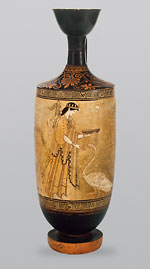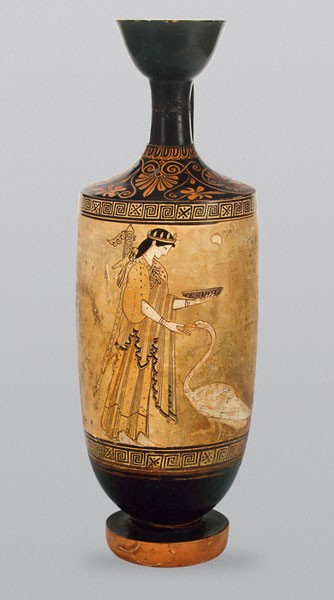Lasting Beauties
See the Show—or Just Buy the Books
“Worshipping Women in Classical Athens,” a gallery exhibition in Manhattan now through May 9, presents book lovers with Hobson’s choice: travel to midtown, visit the show, and feast on dozens of images from some of the world’s best museums; or spend what may be a comparable sum to acquire a recent book about ancient Greek priestesses, Portrait of a Priestess, by Joan B. Connelly (Princeton University Press, $45, with 27 color plates and 109 half-tones). It won’t make sense to see the exhibit and buy the book. Images of ancient Greek women at worship, images of the goddesses that they adored, and images of ancient Greek priestesses are dizzyingly alike. That’s the charm in this prestigious but little-known subject.
Maybe it was that Mediterranean climate, which allowed women to wear what today seems like just enough; or maybe it was the penchant of ancient Greeks to imagine goddesses as BC-movie stars; or maybe it was all the wine-pouring and barbequing of pagan Greek religion; but worshippers, goddesses and priestesses all have the sleek, happy step of fashion models on break during a shoot in the Hamptons. The fey silhouettes, the slender bare feet, the curly hair coiffed to a fault—why can’t more of us look like that? The one thing scholars can’t find is a portrait of an Attic damsel who is fat.
“Worshipping Women” is an act of largesse from the Onassis Foundation, created by the late shipping magnate Aristotle Onassis. A labyrinthine basement in a midtown skyscraper houses the 155 sculptures, bas-relief friezes, vases and other vessels lent by museums in Greece, Europe and the U.S., including the nearby Metropolitan. These objects depict goddesses in quotidian poses, like Artemis petting a swan, and a helmeted Athena taking notes on a wax tablet. Here, too, are priestesses carrying massive metal temple keys; girls impersonating bear cubs (in honor of Artemis, who was likened to a bear); young women carrying jugs of wine for pouring at sacrifices or ceremonial moments like arrivals and departures; and women of all ages mourning the death of Adonis, Aphrodite’s lover, by the ritual of putting plants in broken pots on the roofs of their homes to wither in the sun and die prematurely, like Adonis himself.
The profusion of images of women in every aspect of ancient Greek religion is stunning not only in comparison with the modest role of women in other areas of ancient life, such as politics, but also in comparison with the much less modest but still circumscribed role of women in many religions today, including Christianity. Especially telling are the images of ancient priestesses conducting rituals similar to those in the Catholic and Orthodox churches, where the celebrants would all be priests.
Why did Christianity cut women out of the picture? The question invites more pondering than a tantalizing but cramped exhibit allows, and points to Portrait of a Priestess. This smooth but learned volume includes many of the same images as the show. It adds 456 pages of text that say mostly what pictures say better: Ancient Greek religion was no version of a men’s club. For every priest, there was or could have been a priestess, even in the highest posts. And no Greek priest was as important a prophet as the priestess of Apollo at Delphi, the Pythia (so called after a snake slain by Apollo). She inhaled intoxicating but not fatal gases emitted from a chasm under the Delphic temple, and gave forth the utterances turned by her temple staff into the most famous prophecies in antiquity. Some of these prophecies shaped Greek and international business and warfare.
No one could be less like the Greeks than the people who study them. The author of Portrait, art professor Joan Breton Connelly, got a half-million-dollar MacArthur grant to write the book, and then holed up in libraries far from ancient ladies—in Philadelphia, at that. Her book was, she says, very much “a Bryn Mawr project,” thanks to the good Greek and Art History libraries at that suburban Philadelphia college. Sexagenarian Charles Scribner III, a friend of Professor Connelly’s, helped pay for the color plates. The company of old, rich Mainliners leads to scholarly success as well as to Bryn Mawr.
Ancient Greek religion was no version of a men’s club.
So how should you spend your money—on a trip to the gallery or on the book? If you fly into Manhattan, the trip may be at least 20 times more expensive. If you buy the book, you may never see part of the top of your coffee table again. There’s a better way to spend your money or decorate your table. Go to the Antiquarian Booksellers Association site (abaa.org) and browse for old art books with line drawings of pictures from Greek vases. For example, a book by the late director of the Boston Museum of Fine Arts, Arthur Fairbanks, Athenian Lekythoi with Outline Drawing in Matt Color on a White Ground (Macmillan, 1914), may be had for $150 or less.
Line drawings from pictures were a common way to depict Greek vases down through the early 20th century. Delicate, clear, and simple, they surpass all other kinds of images in rendering scenes of ancient Greek daily life. Color reproductions run the risk of worse quality or excessive power. Black and white photos have the opposite drawbacks—sometimes better quality but a faint overall impression.
Only drawings—the kind of thing Charles Scribner senior would have collected—preserve the contours and sharpness characteristic of the Greek landscape and the social life that landscape inspired. And the old art books are not always as expensive as that $1,000 trip to New York. Yes, they cost more than $45, but they have something in common with the vases rendered in them. They’ve lasted.
“Worshipping Women: Ritual and Reality in Classical Athens,” is at the Onassis Cultural Center in Manhattan through May 9, 2009.










